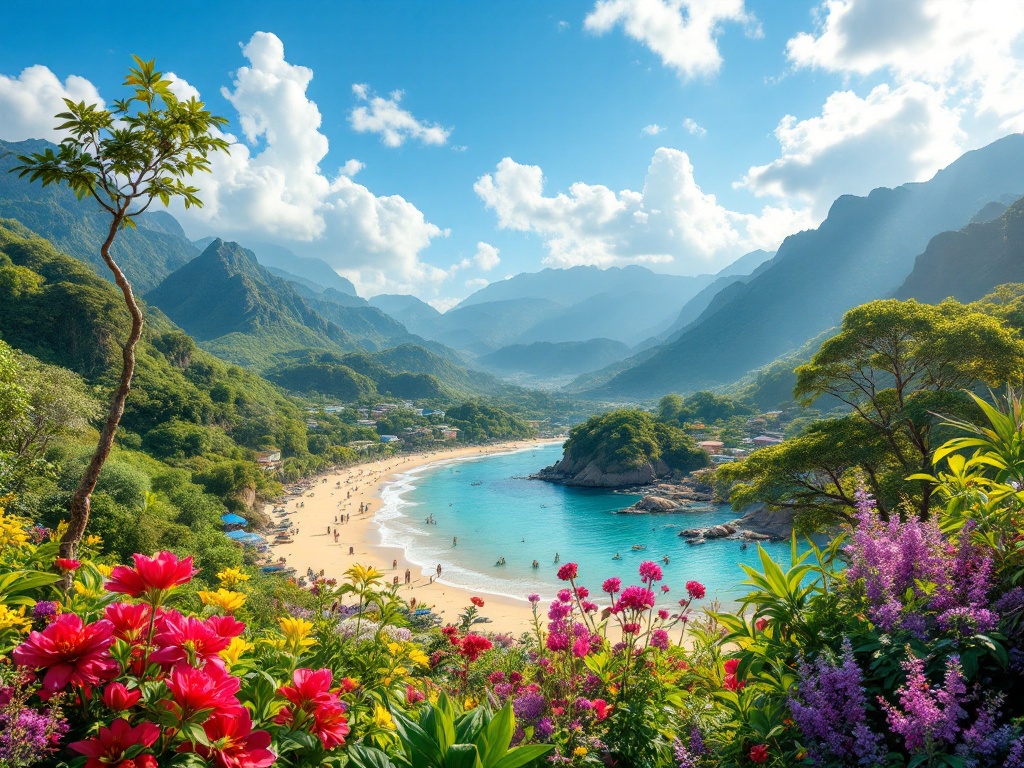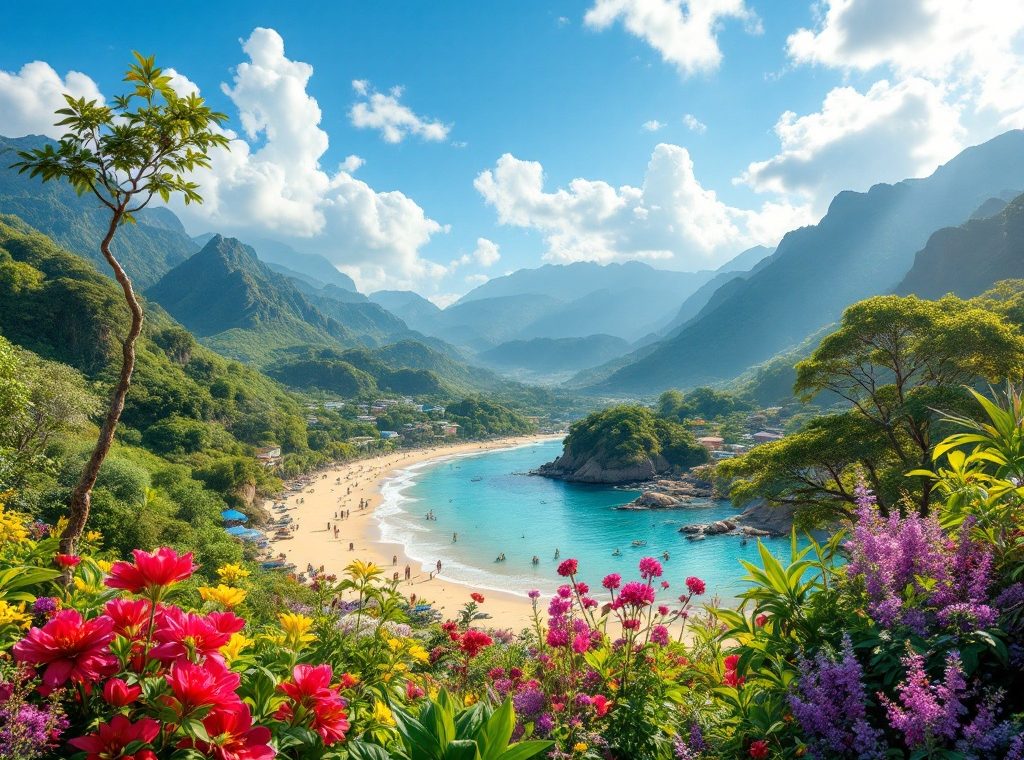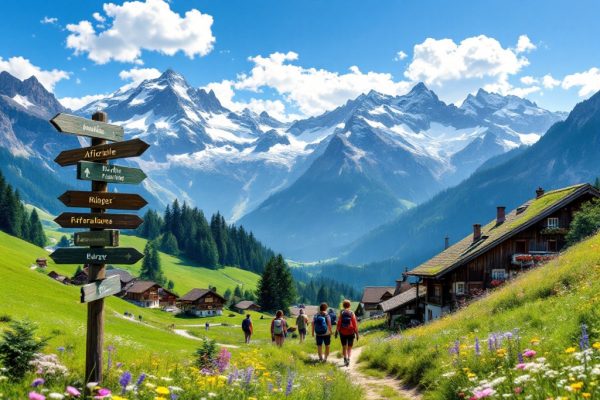What’s the Best Time to Visit Colombia? Seasonal Travel Guide
Dreaming of a Colombian adventure? Discover the perfect time to explore this diverse country, from Cartagena’s sunny beaches to Medellín’s vibrant Flower Festival. Colombia’s unique climate, influenced by altitude rather than traditional seasons, offers year-round opportunities for adventure. Whether you’re seeking dry-season hikes in Tayrona National Park or rainy-season wildlife viewing in the Amazon, this guide reveals the ideal time to visit based on your interests. Uncover the magic of Colombia’s microclimates and plan your unforgettable trip today!
Important information

- Colombia has a tropical climate influenced by altitude, creating diverse microclimates from hot coasts to cool Andes mountains.
- Dry seasons (December-March, July-August) offer the best weather for outdoor activities, but also higher prices and more tourists.
- Rainy seasons (April-June, October-November) are ideal for wildlife viewing and budget travel, with fewer crowds and lush landscapes.
- The best time to visit depends on your interests: August for Medellín’s Flower Festival, July/August for whale watching, or June/November for Amazon adventures.
- Always consider regional microclimates when packing; layers for mountains, light clothes for coasts, and rain gear for the Amazon are essential.
Colombia’s Climate and Seasonal Overview
Colombia’s proximity to the equator gives it a warm, tropical climate, but its diverse landscapes create a variety of microclimates. Coastal cities like Cartagena and Medellín have warm, dry weather, averaging 86°F (30°C), with rainier periods from April to June and again in October and November. However, altitude significantly affects temperature. Ascending into the Andes, even during the summer months, reveals much cooler conditions. Elevation, not traditional seasons, determines temperature variation in Colombia, resulting in a fascinating range of weather experiences.
Understanding Colombia’s Tropical Climate
Colombia’s equatorial location gifts it with a tropical climate, making warm weather a year-round expectation. Altitude adds another layer, creating diverse regional microclimates. Coastal areas enjoy higher temperatures, while mountainous regions offer a refreshing coolness. This allows travelers to choose between sun-drenched beaches and invigorating mountain air. Colombia’s diverse climate makes it an ideal destination regardless of the season, offering exciting experiences year-round.
Colombia Weather Patterns: Dry and Rainy Seasons
Colombia experiences two main seasons: dry and wet. The dry season typically lasts from December to March and briefly reappears from July to August. The wet season occurs from April to June and then from October to November, with rainfall varying across regions.
The Best Time to Visit Colombia
Colombia is a fantastic travel destination any time of year, but the dry seasons (December to March and July to August) are particularly popular for their minimal rainfall and pleasant temperatures. These dry months offer unique opportunities, such as whale watching along the Pacific Coast in July and August, which also coincides with Medellín’s vibrant Flower Festival. However, the ideal time for your Colombian adventure truly depends on your interests and chosen region. For example, the Caribbean coast is best explored during the dry season, while the Amazon rainforest thrives during the rainy months. When planning, consider regional climates, local festivals, and your preferred activities to ensure a memorable trip.
Optimal Months for Travel: December, January, July, and August
Planning a trip to Colombia? Consider these prime travel times: December, January, July, or August. January is peak season, offering beautiful weather but also higher prices and more crowds. July is perfect for surfing along the Pacific Coast. If you love flowers, visit Medellín in August for the spectacular Festival of Flowers. December is also a popular time to visit, so book your flights and accommodations early.
Shoulder Seasons: March and June
Colombia’s weather undergoes a significant transformation in March, shifting from dry to wet conditions. Regional variations are notable, however. By June, Bogotá and the Andes Mountains experience pleasant temperatures, perfect for exploring high-altitude areas.
Travel Planning: Itinerary, Interests, and Regional Climates
Discover the diverse climates of Colombia and plan your trip accordingly. Cartagena’s Caribbean coast offers year-round sunshine, perfect for beach lovers. Medellín, nestled in the Andes Mountains, enjoys a temperate climate known as the “City of Eternal Spring”. For a more adventurous experience, explore the hot and humid Amazon rainforest. If you enjoy hiking and exploring national parks, visit during the dry season (December to March). For those who appreciate lush landscapes and diverse wildlife, the rainy season (April to November) offers a unique perspective.
Exploring Colombia by Season
Dry Season (December – March)
Colombia’s dry season offers minimal rainfall, making it ideal for exploring cities, historical sites, and coffee plantations. Tayrona National Park becomes easily accessible during this time. Experience vibrant cultural events such as Barranquilla’s Carnival and Easter celebrations. Be prepared for increased prices and tourist crowds.
- Minimal rainfall.
- Ideal for exploring cities, historical sites, and coffee plantations.
- Easy access to Tayrona National Park.
- Vibrant cultural events (Barranquilla’s Carnival, Easter celebrations).
- Higher prices and increased tourist crowds.
Rainy Season (April – November)
While rain is more frequent during these months, it’s not constant, allowing for exploration amidst lush landscapes. Enjoy fewer crowds and lower prices. This period offers unique experiences: prime stargazing in the Tatacoa Desert (June-September), Sierra Nevada hikes (June-August), and exceptional Amazon wildlife viewing (June-November) during its dry season.
- More frequent rainfall (but not constant).
- Lush landscapes.
- Fewer crowds and lower prices.
- Prime stargazing in the Tatacoa Desert (June-September).
- Sierra Nevada hikes (June-August).
- Exceptional Amazon wildlife viewing (June-November).
Visiting Colombia in the Dry Season: December to March
Colombia truly shines during its dry season, from December to March. This period is perfect for outdoor lovers, offering chances to hike through Tayrona National Park or relax on the Caribbean beaches.
- Ideal time for outdoor activities, such as hiking in Tayrona National Park or relaxing on Caribbean beaches.
- Experience the vibrant Barranquilla Carnival.
- Explore coffee plantations during the harvest season in the Coffee Triangle.
- Enjoy warm, sunny days perfect for sightseeing in Bogotá and Medellín.
The dry season also offers vibrant cultural experiences, like the spectacular Barranquilla Carnival. The Coffee Triangle region is bustling with the coffee harvest, making it a great time to tour the plantations. City lovers will find Bogotá and Medellín equally appealing, with ideal weather for sightseeing. Book accommodations and tours in advance, as this is a popular time to visit.
Visiting Colombia in the Rainy Season: April to November
For nature lovers, Colombia’s rainy season, from April to November, offers a unique experience. The increased rainfall transforms the already lush landscapes into vibrant ecosystems, teeming with wildlife. The Amazon and Los Llanos regions are especially rewarding during this time.
- The Caño Cristales, or “River of Five Colors,” displays its vibrant hues most vividly during the rainy months.
While rain is more frequent, it usually comes in short bursts, often leaving mornings clear and perfect for exploring. Be prepared for wet weather in the afternoons, and pack accordingly. An advantage of traveling during the rainy season is encountering fewer crowds and benefiting from lower prices than in the dry season.
Regional Guide: Best Time to Visit Colombia’s Top Destinations
The Coffee Triangle, nestled between Armenia, Pereira, and Manizales, is ideal during the dry seasons, from December to March or July to August. These months are perfect for exploring coffee plantations and hiking the Cocora Valley.
Medellín, known as the “City of Eternal Spring,” boasts pleasant weather year-round. However, August truly shines with the vibrant Feria de las Flores (Flower Festival), a spectacle of parades and cultural events.
Colombia’s Caribbean Coast offers warmth year-round. While the dry season, from December to March, is popular, the wet season (April to November) remains appealing with warm temperatures, though with higher humidity and occasional rain.
The Amazon Rainforest welcomes adventurers year-round. The dry season, from June to November, offers optimal wildlife viewing. The wet season (December to May) boasts lush vegetation and easier river navigation due to increased water levels.
The Coffee Triangle: Best Months and Activities
Visit Colombia’s Coffee Triangle during the dry season, from December to March, or in July and August for shorter sunny periods. February is perfect for experiencing the coffee harvest firsthand on a tour. These dry months are ideal for outdoor activities like hiking and biking, allowing you to explore the region’s landscapes.
Medellín: Enjoying the Festival of Flowers in August
Experience the vibrant Feria de las Flores (Flower Festival) in Medellín every August. This lively Colombian celebration honors Medellín’s rich history, flower cultivation, and cultural heritage. Streets are filled with elaborate flower displays, parades, traditional music, and dance, creating an electric atmosphere. The highlight is the Desfile de Silleteros, a parade of flower growers (silleteros) carrying enormous flower arrangements on their backs, a tradition passed down through generations. Medellín’s pleasant August weather makes it the perfect time to experience this captivating festival.
Caribbean Coast: Navigating the Wet Season
The Caribbean coast’s wet season arrives during September and October. While hurricanes are rare, pack for rain to be prepared for the occasional shower. Travel is still perfectly feasible.
Amazon Rainforest: Wildlife and Adventure Travel
Planning your Amazon adventure? The dry season, from June to November, offers incredible wildlife viewing as animals gather around limited water sources. The rainy season, December to May, while wetter, boasts unique animal encounters and lush, vibrant landscapes. Be prepared for rain regardless of the season. Hiking is best between October and November when water levels are low, but be mindful of potential flash floods in coastal areas.
Colombia Month-by-Month Weather Guide
January and February: Peak tourist season with sunny, dry weather, perfect for exploring diverse landscapes, from the Andes to the Coffee Triangle. Cities like Cali, Medellin, and Bogota are also enjoyable.
March and April: Transition to the rainy season. March often has clear skies, ideal for continued exploration. April sees increased showers, especially around Easter, but city visits remain pleasant.
May and June: Wetter months, with the Caribbean Coast experiencing more rain in May. June’s rainfall varies, with some areas staying dry. The Andes remain accessible.
July and August: Popular months for whale watching on the Pacific Coast and festivals, including Medellin’s Flower Festival in August. Sunny weather prevails.
September and October: The wettest months. Despite the rain, temperatures remain consistent, and Caño Cristales is a vibrant destination.
November and December: November experiences significant rainfall. December marks the start of the dry season, attracting visitors with favorable weather for holiday travel.
January and February: Peak Season Highlights
The peak tourist season falls between January and February, offering dry weather and comfortable temperatures perfect for outdoor activities. This period also features a lively calendar of cultural events and festivals.
March and April: Transitioning to the Rainy Season
Colombia’s weather changes significantly during March and April. March offers warmer temperatures and lower humidity, making it an ideal time to visit.
April marks the beginning of the rainy season, which typically lasts until late May. This makes April less suitable for exploring most of Colombia, although some regions, like the Caribbean coast and Tayrona National Park, remain appealing. Be aware that Easter often falls in April, potentially leading to crowded roads and limited accommodation. Therefore, booking your trip in advance is highly recommended.
May and June: Exploring the Andes
While May’s rain could hinder travel, June offers sunnier skies perfect for exploring the Andes. Bogota and its surrounding mountain ranges are particularly enjoyable during this month, making June an ideal time for a visit.
July and August: Surfing and Festivals
Colombia’s Pacific Coast is a prime destination in July and August. Surfers will find ideal wave conditions during these months. July often offers drier weather, perfect for exploring the outdoors.
- ideal wave conditions,
- drier weather,
- humpback whale migration.
August is known for its vibrant cultural festivals. Experience the renowned Festival of Flowers in Medellín. Another highlight of July is the awe-inspiring migration of humpback whales along the Pacific Coast.
- vibrant cultural festivals,
- Medellín’s renowned Festival of Flowers.
September and October: Wettest Months
Colombia experiences its heaviest rainfall in September and October. While September’s downpours primarily drench the Caribbean coast, October brings widespread rain across the country. Travelers during these months should be prepared for wet weather and consider indoor pursuits or rainy-day adventures in nature. The Amazon rainforest, however, remains perpetually drenched, experiencing rainfall year-round.
November and December: Preparing for Holiday Travel
While November sees rainfall in many areas, December marks the start of the tourist season. It’s a peak time for visitors, with an array of festivals and holiday events. Due to high demand, booking flights and accommodations in advance is highly recommended.
Adventure and Nature Activities by Season
Colombia’s dry season, from December to March, offers ideal hiking conditions. Comfortable temperatures and clear trails await in national parks like Tayrona, known for its coastal trails and beaches, and Los Nevados, offering high-altitude trekking amidst volcanic landscapes.
The rainy season, from April to November, reveals a different side of Colombia. Lush vegetation flourishes, creating a haven for wildlife, particularly in the Amazon rainforest. The rain often subsides at night, unveiling stunning starscapes, especially in the Tatacoa Desert, renowned for minimal light pollution.
For year-round hiking, consider the Sierra Nevada de Santa Marta, the world’s highest coastal mountain range. The dry seasons (December to March and June to August) offer predictable weather. The rainy season provides a unique perspective, showcasing lush greenery and cascading waterfalls, but be prepared for potential trail closures due to heavy rainfall.
Dry Season Adventures: Hiking and National Parks
Colombia shines from December to March, its dry season offering perfect conditions for hikers and park explorers to discover the country’s diverse landscapes. While this period is peak tourist season due to the ideal weather and may draw larger crowds, careful planning ensures an enjoyable exploration of Colombia’s natural beauty.
Rainy Season Activities: Wildlife Spotting and Stargazing
For prime wildlife viewing, visit between April and June or October and November during the rainy season. The lush vegetation makes spotting animals easier, particularly in the biodiverse Amazon and Los Llanos regions. While rain showers are common, they’re often brief, leaving mornings clear. As a bonus, the Tatacoa Desert offers superb stargazing from June to September when even the rainy season boasts clearer night skies.
Highland Adventures: Hiking in Sierra Nevada de Santa Marta
The Sierra Nevada de Santa Marta mountains offer fantastic hiking, especially during the dry season. The dry season spans from December to March and again from June to November. Time your trek for optimal conditions.
Colombia Travel Tips and Recommendations
Colombia boasts diverse microclimates, from humid coasts to the cool Andes and the Amazon rainforest. This variety offers travel options for every season and budget. Peak season, from December to January and July to August, offers ideal weather but higher prices. For pleasant temperatures and fewer crowds, consider visiting from March to June or September to November. Budget travelers can find the best deals during the low season (April-May and October-November), experiencing Colombia with fewer crowds but a chance of rain.
Understanding Colombia’s Microclimates
Colombia’s diverse landscapes offer a fascinating array of microclimates, where weather can change dramatically within short distances. The Andes Mountains create distinct temperature zones. Coastal regions are hot and humid, while higher altitudes offer cooler temperatures. Medellín, nestled in a valley, enjoys pleasant, spring-like weather year-round. The Amazon region is characterized by its hot, humid, and rainy climate. The Guajira Peninsula presents a stark contrast with its arid desert landscape.
Understanding Colombia’s Microclimates is Key to Packing
To fully enjoy your Colombian adventure, understanding these microclimates is essential for packing and planning. Mountain trekkers should bring layers, while coastal visitors can pack light clothing. Don’t forget rain gear for the Amazon. Be ready for anything in Colombia’s dynamic climate.
Weather Overview
- Coastal Regions: hot and humid.
- Higher Altitudes: cooler temperatures.
- Medellín: pleasant, spring-like weather year-round.
- Amazon Region: hot, humid, and rainy.
- Guajira Peninsula: arid desert landscape.
Travel Tips for Peak, Shoulder, and Low Seasons
For a smooth trip, consider traveling during the shoulder seasons (March-June, September-November) for pleasant weather and fewer crowds. Flexibility and searching for travel deals are always recommended.
While peak season (December-January, July-August) can be exciting, it’s wise to book flights and accommodations well in advance and consider travel insurance.
Alternatively, the low season (April-May, October-November) offers unique advantages like unparalleled wildlife viewing and nature exploration, though rain is more frequent so pack accordingly.














